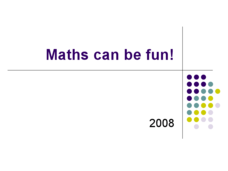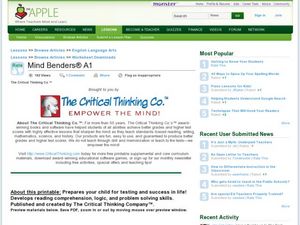Curated OER
Fill It Up
In this filling in a chart worksheet, 3rd graders write a specific number in 15 boxes that fits the rule for each column and row. Students can use any number only once.
Curated OER
Smart Shopping
In this exact change worksheet, 3rd graders look over a price list and circle each item that Danielle can buy with 3 quarters, 2 dimes, a nickel and a penny. Students find five groups of items that Danielle can buy together with the...
Curated OER
Sum Machine!
In this addition learning exercise, 2nd graders find the sum of 14 addition math problems involving three-digit whole numbers. Students write 1 original addition problem that can be solved.
Curated OER
Story Time
In this number sentences worksheet, 2nd graders look at 4 number sentences and tell a story about each one. Students draw a picture about each of their stories.
Curated OER
Find the Fake
In this division problems worksheet, 3rd graders look at 7 rows of division problems and determine which one of the four on each row does not belong with the other three. Students circle their answers.
Curated OER
Fun Math Quiz
Quizzes can be a fun way to review math concepts while building proficiency. Kids answer sixteen different problems that cover algebraic reasoning, geometry, addition, multiplication, and word problems. This is a dynamic quiz that is...
Odyssey of the Mind
Odyssey of the Mind Curriculum Activity: Made Up Math
Is there a way to connect creative thinking, logical reasoning, mathematical understanding, and humor? You bet there is! Kids begin by creating creative math quizzes, which require creative thinking to solve. For example, 1+1=24, one...
Curated OER
The House on Haunted Hill
Have your class practice problem solving and critical-thinking skills. Learners read a long story about an adventure involving a haunted house, make decisions about what the character should do, and evaluate the storytelling process.
Curated OER
Who am I?
For this reading comprehension and logical thinking worksheet, young students read descriptions and then guess the name of each one of the 8 bears.
Stanford University
Chronology: Civil Rights in the 20th Century
Test pupils' knowlege of history and the way civil rights movements unfolded using a series of images. With a primary source analysis activity, scholars practice their chronology and deductive reasoning skills. They use their knowledge...
Illustrative Mathematics
Points equidistant from two points in the plane
Young geometers apply their deductive reasoning skills and knowledge of proving triangles congruent in a task that asks them to prove if a point lies on the perpendicular bisector of a segment, then it is equidistant from the endpoints...
Illustrative Mathematics
Seven to the What?!?
Sometimes what seems like the easiest problem is really the most difficult. Your class is first going to reach for their calculators, but will realize the number is too large to evaluate. Now what? This is where the fun and the logical...
ConnectED
Crime Scene Investigation
How exactly does a crime scene investigation work? The resource, a unit on criminology, covers everything from the deductive reasoning skills needed for detectives to DNA fingerprinting, all the way to how to gather evidence and bring...
Curated OER
Quadrilateral Investigation
A good classroom tool is always great to have around. This tool provides learners with an opportunity to view and investigate the properties of quadrilaterals. Each slide contains images of a square as it is dissected into various...
Curated OER
Mathematical Magazines
Learners use ads from magazines to create data to be measured and apply the skill of estimation. They record the percentage of magazine ads that could be separated into different categories made by students through the use of logical...
Curated OER
Tennis Playing Family
In this secondary mathematics worksheet, high schoolers use logical thinking to solve a verbal problems in which they determine who is the worst tennis player in a family. The one page worksheet contains one problem with the solution.
Curated OER
Mind Benders: Name the Animals
In this deductive reasoning learning exercise, students read the clues about a cat, a small do, a goat, and a horse and identify them. Students solve 3 answers.
Noyce Foundation
Perfect Pair
What makes number pairs perfect? The resource provides five problems regarding perfect pairs of numbers, the definition of which changes in complexity with each task. Solutions require pupils to apply number sense and operations, as well...
Noyce Foundation
Diminishing Return
Challenge individuals to compete as many tasks as possible. Lower-level tasks have pupils apply costs and rates to solve problems. Upper-level tasks add algebraic reasoning and conditional probability to the tasks.
Curated OER
Problem-Solving Strategy: Use Logical Reasoning homework 3.3
In this using logical reasoning to solve word problems worksheet, students use the logical reasoning problem solving strategy of drawing a table to solve word problems. Students solve two problems.
Curated OER
Two Column Logic Proofs
Young scholars complete two column proofs. In this geometry lesson plan,students derive the reasons their answers are correct using logic. They write the proof step by step using two columns.
Curated OER
Raging River
In this measurement worksheet, 3rd graders read a passage on the Mississippi River and then answer five short answer questions relating to the length of the river.
Curated OER
Logic and Proof Writing
Students define inductive and deductive reasoning and write two column proofs. In this geometry instructional activity, students analyze arguments and draw conclusion. They define steps necessary to arrive at the correct answer when...
Curated OER
Crossing Paths
In this completing a chart worksheet, 3rd graders fill in 22 items or category titles to two charts involving animals and fruit. Students choose their answers from a word bank.

























